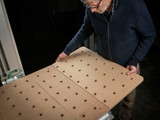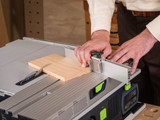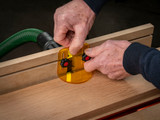Blog
Systainer Storage Guide: Organize Your Workshop Tools
Picture this: you're setting up for what should be a straightforward series of cuts, but you can't locate the specific guide rail stop you need. Twenty minutes later, after searching through three different toolboxes and moving aside piles of loose accessories, you finally find the component buried at the bottom of a drawer. Now multiply those twenty minutes by every time you've hunted for a missing accessory, small component, or specialty tool during setup. Over a year, those frustrating search
…
2nd Sep 2025
Build Your Own MFT Workbench: Complete MFT DIY Guide
The Multi-Function Table—or MFT workbench as many call it—has become the Swiss Army knife of modern workshops. Originally developed by Festool, this perforated work surface transforms how you approach precision cutting, assembly, and project layout.
While commercial MFT tables deliver excellent performance, creating your own custom MFT setup gives you real advantages: complete customization to fit your space and workflow, the ability to integrate features that manufacturers charge ex
…
23rd Aug 2025
Rip Cut vs Crosscut: What Every Woodworker Should Know
You're halfway through cutting a board when the blade binds, the wood splinters, or worse—you experience kickback. More often than not, the culprit isn't user error or faulty equipment, it's using the wrong cutting approach for the grain direction.
Understanding the difference between rip cuts and crosscuts isn't just woodworking theory, it's the foundation of safe, efficient work that produces clean results every time. Whether you're dimensioning lumber for a cabinet project or breaking d
…
22nd Aug 2025
Router Dust Collection: How to Tame One of the Dustiest Tools in Your Shop
Routers are among the most versatile tools in a woodworker’s shop—but they’re also some of the messiest. Whether you’re flush trimming, edge profiling, or routing dados, the fine dust and chips produced by a router seem to go everywhere. And unlike larger stationary tools, routers often operate in open-air configurations, making it difficult to contain that debris.
Controlling router dust isn’t just about keeping your workspace tidy. Fine airborne dust poses a long-
…
2nd Jul 2025
Workshop Dust Collection: Smarter Setups for Safer Shops
Wood dust is more than just a nuisance—it’s a real hazard. While sweeping up chips might seem like the main concern, the fine airborne dust is the biggest threat. These particles are small enough to linger in the air and reach deep into your lungs, and over time, that exposure can have serious health consequences. Respiratory irritation, reduced lung function, and even cancer have all been linked to prolonged wood dust inhalation.
The good news? A well-designed dust collection system
…
12th May 2025
Building a Profitable Woodworking Business: Insights from Craftsman Peter Eskildsen
Transitioning from weekend hobbyist to profitable woodworker requires more than just skill at the bench. Peter Eskildsen, owner of Peter's Custom Woodworking since 1993, has built a thriving business by mastering both craft and client relationships.
His top strategies for woodworking profitability include:
Taking small jobs that often lead to larger opportunities
Building loyal client relationships for consistent work
Being selective about which projects to accept
Working efficiently with
…
3rd Apr 2025
Workshop Organization Guide: Storage Solutions & Layout Tips
If there’s one thing I’ve learned as a woodworker, it’s that your workshop organization is never truly "done." No matter how dialed-in your setup seems today, a new tool, a new project, or just a better way of doing things will inevitably send you back to the drawing board. And honestly, that’s part of the fun. A well-organized shop isn’t just about keeping things tidy—it’s about making sure your storage solutions works with you, not against you.
In
…
4th Mar 2025
Woodshop Tool Maintenance & Storage: Preparing Your Shop for the Winter Months
Winter's approach means more than just a change in temperature for those of us with serious shops. Beyond the annual ritual of winterizing our homes, those of us who take our woodworking seriously face another critical task: protecting our workshops and the precision tools within them.
The stakes are especially high for those of us working with cast iron tools, which are particularly vulnerable to the season's challenges. Whether you're in the humid Southeast where temperature swings can cr
…
27th Jan 2025
Can You Use a Track Saw To Joint Boards?
Jointing boards is a crucial step in woodworking and generally involves flattening one face and one edge of your stock. From there, a planer and table saw can be used to square and parallel the opposite edges, resulting in parallel and square stock ready for fine woodworking. While the jointer and planer have traditionally been the tools of choice for milling, many woodworkers wonder if a track saw can play a part in the process. We’ll explore the possibility of using a track saw to joint b
…
3rd Jul 2024
Can a Circular Saw Be Converted Into a Track Saw?
Track and circular saws serve distinct purposes in the world of woodworking and construction. While both tools can make straight cuts, they have significant differences that typically prevent a straightforward conversion from one tool to the other. Here are some key reasons why a circular saw can't convert into a track saw. Base DesignOne of the primary differences between a circular saw and a track saw is their base design. A track saw features a specialized base with a groove that fi
…
6th Jun 2024










